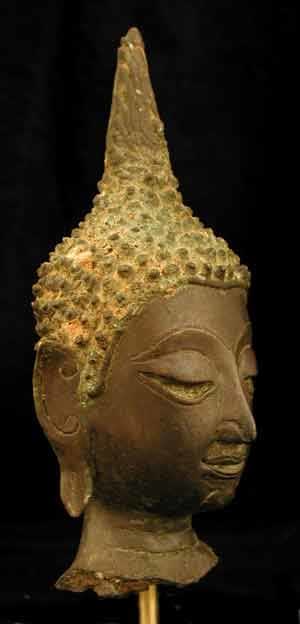Ayutthaya Bronze Head of the Buddha, 1350 CE - 1564 CE
Bronze
17.8 x 8.9 cm
7 x 3 1/2 in
7 x 3 1/2 in
PF.5781
Further images
The establishment of the new kingdom of Ayutthaya in the middle of the 14th century and the change of the political center of Thai power from Sukhothai to Ayutthaya marked...
The establishment of the new kingdom of Ayutthaya in the middle of the 14th century and the change of the political center of Thai power from Sukhothai to Ayutthaya marked the beginning of a new era of great cultural prosperity. From the capital city of Ayutthaya located at the confluence of three rivers (the Chao Phraya, the Pasak, and the Lopburi) the kingdom of Ayutthaya dominated Menam Basin for over four centuries. However, it is clear that this strategic geographical and economical site had been settled by an ancient community, long before King Ramathihodi I traditionally founded the city. Ramathihodi I was a renowned warrior and lawmaker. Under his leadership, and under his immediate successors, the kingdom rapidly expanded north towards Sukhothai and east towards the Khmer capital of Angkor Wat, which they managed to seize for a brief interval. Under royal patronage, Buddhism flourished and Ayutthaya became an important Buddhist center. The rulers of this dynasty, like the rulers of the Sukhothai Kingdom, patronized cultural and religious intercourse between Sri Lanka and Thailand and encouraged and supported the development and propagation of Sihala Buddhism in Thailand. Centuries of battles with the Burmese would eventually culminate in the sacking and burning of Ayutthaya in 1767, thus ending one of the most prosperous and culturally influential periods in Thai history.
This bronze sculpture of the Buddha’s head masterfully conveys the profound serenity and tranquility personified by this great religious figure. His large, closed eyes reveal that the Buddha is in a state of deep meditation. His sweetly smiling face embodies an inner calm and complacency, both with the world and with his state of being. His ears droop down from the weight of heavy ear ornaments. The Buddha’s distinctive hairstyle is typical of Thai representations. The coiffure of tight curls covering his head has acquired a fabulously rich patina in between the grooves over the ages. The large flame rising from the top of his head is symbolic of the Buddha’s enlightenment and his infinite wisdom. The sculpture has also added the subtle folds of fat around his neck, again indicative of the fullness and self-satisfaction characterized by the Buddha. Overall, this exquisite sculptural fragment beautifully memorializes one of history greatest holy figures.
This bronze sculpture of the Buddha’s head masterfully conveys the profound serenity and tranquility personified by this great religious figure. His large, closed eyes reveal that the Buddha is in a state of deep meditation. His sweetly smiling face embodies an inner calm and complacency, both with the world and with his state of being. His ears droop down from the weight of heavy ear ornaments. The Buddha’s distinctive hairstyle is typical of Thai representations. The coiffure of tight curls covering his head has acquired a fabulously rich patina in between the grooves over the ages. The large flame rising from the top of his head is symbolic of the Buddha’s enlightenment and his infinite wisdom. The sculpture has also added the subtle folds of fat around his neck, again indicative of the fullness and self-satisfaction characterized by the Buddha. Overall, this exquisite sculptural fragment beautifully memorializes one of history greatest holy figures.









